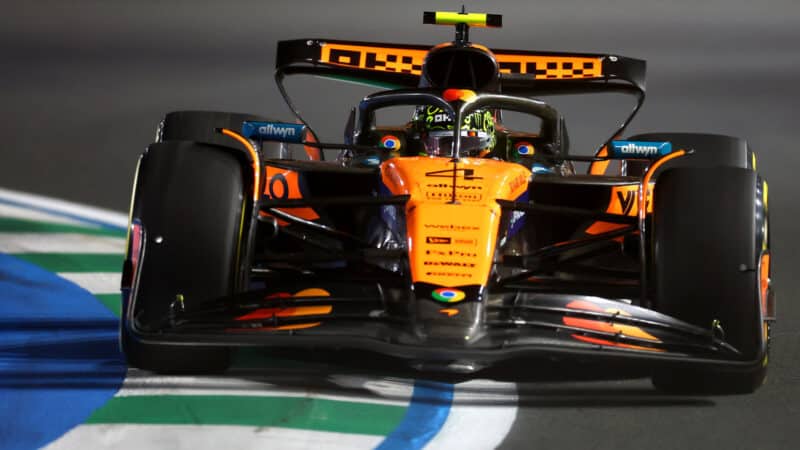2025 Saudi Arabian GP FP2 results - Norris fastest as Tsunoda crashes
Norris led a McLaren 1-2 in second practice at Jeddah as Red Bull's Tsunoda crashed against the wall

Norris led second practice from team-mate Piastri
Getty Images
Lando Norris led a McLaren 1-2 in second practice for the 2025 Saudi Arabian Grand Prix, heading Oscar Piastri in the night-time session.
Championship leader Norris outpaced Piastri by 0.163s with a time of 1m28.267s, the duo leading the Red Bull of Max Verstappen, who enjoyed a better session than in the afternoon and wound up over two tenths behind the Briton.
The 60 minutes of running were interrupted by a red flag with little over five minutes to go after Yuki Tsunoda crashed his Red Bull into the wall at the final corner.
Tsunoda initially brushed the inside wall too hard going into the corner, his car being sent straight into the right side of the track, impacting heavily against the barriers.
The Japanese driver was uninjured, but the right side of his car was heavily damaged. The session resumed with just a few seconds to go.
Charles Leclerc in the Ferrari and Williams‘ Carlos Sainz completed the top five.
Leclerc’s team-mate Lewis Hamilton was involved in an impeding incident with Alexander Albon, the British driver getting in the way of the Williams after the start of the session. Stewards investigated it once practice finished and decided that no further action was necessary.
Aston Martin‘s Lance Stroll caused another of the few incidents of the session when he spun at Turn 2 some 10 minutes into practice. He managed to keep going without hitting anything.
Gabriel Bortoleto was unable to set a timed lap after his Sauber suffered a fuel leak, leaving him stranded in the garage.
2025 Saudi Arabian GP second practice results
| Pos | Driver | Team | Time | Gap | Laps |
| 1 | Lando Norris | McLaren | 1:28.267 | 21 | |
| 2 | Oscar Piastri | McLaren | 1:28.430 | +0.163s | 22 |
| 3 | Max Verstappen | Red Bull | 1:28.547 | +0.280s | 23 |
| 4 | Charles Leclerc | Ferrari | 1:28.749 | +0.482s | 22 |
| 5 | Carlos Sainz | Williams | 1:28.942 | +0.675s | 24 |
| 6 | Yuki Tsunoda | Racing Bulls | 1:28.963 | +0.696s | 19 |
| 7 | George Russell | Mercedes | 1:28.973 | +0.706s | 21 |
| 8 | Pierre Gasly | Alpine | 1:29.106 | +0.839s | 22 |
| 9 | Nico Hülkenberg | Sauber | 1:29.193 | +0.926s | 21 |
| 10 | Alex Albon | Williams | 1:29.220 | +0.953s | 23 |
| 11 | Kimi Antonelli | Mercedes | 1:29.242 | +0.975s | 16 |
| 12 | Isack Hadjar | Racing Bulls | 1:29.306 | +1.039s | 17 |
| 13 | Lewis Hamilton | Ferrari | 1:29.371 | +1.104s | 23 |
| 14 | Liam Lawson | Racing Bulls | 1:29.488 | +1.221s | 22 |
| 15 | Fernando Alonso | Aston Martin | 1:29.662 | +1.395s | 18 |
| 16 | Oliver Bearman | Haas | 1:29.754 | +1.487s | 19 |
| 17 | Jack Doohan | Alpine | 1:29.912 | +1.645s | 21 |
| 18 | Lance Stroll | Aston Martin | 1:30.007 | +1.740s | 18 |
| 19 | Esteban Ocon | Haas | 1:30.019 | +1.752s | 22 |
| 20 | Gabriel Bortoleto | Sauber | no time | 23 |
